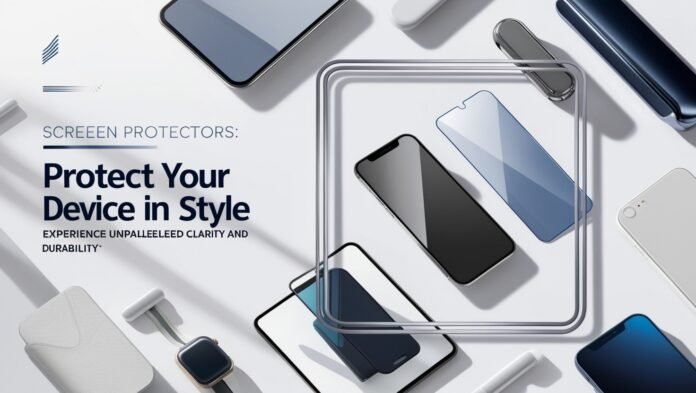Screen Protector are essential accessories designed to shield your devices from scratches, cracks, and other damage.With the advent of smartphones, tablets, laptops, and other gadgets in the current age, it is becoming increasingly important to ensure that these devices remain undamaged.
Thus, Screen Protectors and even cases have become common accessories in order to protect the screens from scratches, cracks, and other types of wear and tear. This paper will examine the different types of screen protectors and their pros, and how one can select the appropriate one depending on the gadget.
Table Of Contents
What Are Screen Protectors?
Screen Protectors are either plastic or glass coatings activated on the display screens of electronic gadgets. They are meant to act as a shield from scratches, any high-intensity pressure impacts, and reduce glare and smudging of fingerprints. Protective coverings are present in a range of forms and materials and are mostly used in modern portable electronic gadgets containing screens such as mobile phones, tablets, laptop computers, and even video game devices.

Types OF Screen Protectors
Plastic Film
Also known as a polymer, film-based screen protectors are made out of a thin sheet of either polycarbonate or polyurethane material. These are usually the cheapest and the most basic of all the options available as they help in protecting against scratch and dents to a very small extent. They are very lightweight and easy to fix, but may not be as tough as over types. They also tend to be poor in cushioning high drops.
Tempered Glass Protector
Chemically strengthened glass screen protectors for phones or tablets are capable of withstanding heavy impact in contrast to ordinary glass. They are also free of any distortions or loss of touch sensitivity even after being scratched and even dropped. Most of the tempered glass protectors such as Zagg glass have a coating of oleophobic surface which helps to prevent the glass from fingerprints and smudges. The process is almost always easy and they most often include brace packers with simple direction print.
Privacy
Such screen protectors are meant to limit the screen’s visibility from other angles except that of the user. This is especially beneficial in public surroundings when one does not wish to disclose their information. These screen protectors help in making the screen appear black to anyone sitting beside the device, thereby helping in privacy. These types of privacy filters can come in plastic films or tempered glass.
Anti-Glare
Anti-glare screen guards limit reflection and glare from external light sources, thus enhancing the usability of such devices under the sun or in very bright surroundings. Further, these kinds of screen protectors are particularly advantageous to those individuals who use such devices for very prolonged periods of time so prevention of eye damage can be achieved. These screen protectors are available in both plastic and glass types.

Benefits Of Using Screen Protector
Protection Scratches
Screen protectors add an extra layer of protection from everyday wear and tear caused by items such as keys, coins, or any sharp objects which can scratch the device’s screen.
Protection Impact
The advanced tempered glass protectors are engineered to take impact shock and eliminate cracks or break outs when the device is accidentally dropped, therefore ensuring durability of the device.
Better Retained Worth
Preserving your device screen in its initial condition is highly effective as soon as you decide to resell the gadget. A unit with a faded, dented or shattered screen usually loses a lot of its original value.
Decreased Glare And Fingerprint Smudges
Most of the screen protectors have special coatings that prevent smudging from fingerprints and also reduce glare for a better viewing experience.
Simple To Put On And Remove
The majority of the screen protectors on the market are simple to put in with easy bubble smoothening. Besides, they can also be taken off without leaving any sticky marks.
Choosing Right Screen Protector
When choosing a screen protector, these aspects should be thought about:
- Compatibility: Ensure that the protector is made for your exact device model in order to fit it accurately.
- Material: Choose between a plastic film or a tempered glass depending on the level of protection required and the available finances.
- Place of Use: If the device will be used most often outside and in bright surroundings, consider using anti-glare ones.
- Other Considerations: Where privacy is of importance, buy privacy screen protectors. Where the aim is to increase touch sensitivity, opt for quality tempered glass.
Conclusion
For wearable electronics to be protected from damages, screen protectors must be bought and used. There are different types of such products that include plastic film, glass, privacy shield, and other anti- glare ones depending on one’s preference. There is always a limit to how much damage can be inflicted on a device, and that damage includes scratches, physical impacts, and other factors that could cause wear and tear. These damage will distort the view of the device and hinder the convenience of use. A quality screen protector will ensure that the new look of the mobile gadget is retained for an extensive period as long continuous use and proper care is given.
FAQ’s
What is a film Screen Protector?
It is a very thin, adhesive layer stuck to the screen of a mobile device to protect from scratches, dust, and minor impacts without disturbing sensitivity and brightness.
What is the best type of Screen Protector?
The best Screen Protector would depend on your needs. Tempered glass is much more protective against drops and scratches, but plastic film is thinner, cheaper, and still comes with decent scratch resistance.



